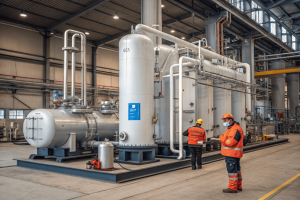How much does a CO2 recovery system cost?
•
How much does a CO2 recovery system cost?
Are you thinking about CO₂ recovery but worried about the high upfront cost? You need to know the price to create a budget and see if it's a wise investment for your facility.
A CO₂ recovery system cost varies widely, from around $100,000 for a small brewery system to over $1 million for a large industrial plant. The total cost depends on the system's capacity, the required gas purity, and the level of automation.

This is always the first question I get from potential clients, and it's the right one to ask. The price tag is important, but it's only one part of the story. The real value comes from understanding what drives that cost and the return on investment you can expect. A CO₂ recovery plant is not just a piece of equipment; it's a financial tool that can pay for itself surprisingly quickly. Let's break down the factors that influence the final price.
Which is the most widely used CO2 separation technology?
You need to capture CO₂, but the market is full of complex technologies. How do you choose the right one without getting lost in technical jargon and making a costly mistake?
The most widely used technology for high-concentration CO₂ sources like fermentation is a multi-stage process of compression, purification, and liquefaction. This method is simple, reliable, and energy-efficient for purifying gas streams that are already rich in CO₂.

When people hear "CO₂ capture," they often think of the massive chemical absorption plants used for power station flue gas. But that technology is overkill for industries like brewing or ethanol production. In our world, the fermentation process has already done the hard work of separating the CO₂ for us. Our job at FTL Machine is not to capture it from a dilute stream, but to purify and liquefy the high-purity gas you already have.
The Purification and Liquefaction Train
Our systems are designed for sources where the gas is over 99% pure CO₂ right from the start. We take this raw gas and turn it into a food-grade liquid. Our process is a physical one, not chemical. It generally involves these steps:
- Gas Boosting & Treatment: The low-pressure gas from the fermenter is collected, scrubbed of water-soluble impurities, and then compressed to a higher pressure.
- Purification: The compressed gas passes through a series of special filters. Activated carbon towers remove any non-condensable gases and trace organic compounds that could affect flavor or aroma. Dehydration units remove any remaining water moisture to prevent ice formation.
- Liquefaction: The clean, dry, high-pressure CO₂ gas is then chilled by a refrigeration system. Under the right combination of high pressure and low temperature, the CO₂ gas changes state and becomes a liquid, ready for storage.
How much does CO2 capture system cost?
You got a quote for a "CO₂ capture system," but the numbers are confusing. You need to understand what factors make the price go up or down to make an informed decision and justify the expense.
The cost of a CO₂ capture system is driven by its capacity (kg/hr), the condition of the inlet gas, your required final purity, and the level of automation. A small, basic system is far cheaper than a large, fully automated one producing food-grade CO₂ with advanced sensors.

When I prepare a quote for a client, I'm not just picking a number out of a hat. The price is built from the ground up based on their specific needs. Two breweries might produce the same amount of beer, but their CO₂ recovery systems could have very different prices based on their operational priorities and quality standards. Understanding these key variables is essential for any project manager or engineer.
Key Factors Influencing Price
Let's look at the main drivers that determine the final capital cost of the equipment. A clear understanding helps you specify a system that meets your needs without overspending.
| Cost Factor | Why It Matters | Impact on Price |
|---|---|---|
| Capacity (kg/hour) | This is the biggest factor. Larger systems need bigger compressors, heat exchangers, and vessels. | The price increases significantly with capacity. It's the primary price driver. |
| Purity Requirements | Meeting food-grade or beverage-grade standards requires more purification steps and advanced sensors. | Higher purity means more sophisticated (and expensive) filters and analyzers. |
| Automation & Control | A fully automated system runs itself, but requires more sensors, a PLC, and a complex control panel. | A manual system is cheaper upfront but requires more operator attention. |
| Site Conditions | Factors like available space, power supply, and cooling water access can affect design. | Custom engineering for tight spaces or special utilities adds to the project cost. |
What are the three basic types of CO2 capture?
You want to make a smart decision, but the terminology is confusing. You hear about pre-combustion, post-combustion, and oxy-combustion and wonder how they relate to the systems you're considering.
The three basic types are pre-combustion, post-combustion, and oxy-fuel combustion. These all relate to capturing CO₂ from burning fossil fuels. A fourth type, direct capture from biological processes like fermentation, is completely different and much simpler.

This is an area that causes a lot of confusion. Those three main types of capture are designed to solve a very difficult problem: separating a low concentration of CO₂ from the massive volume of nitrogen and other gases in the flue gas of a power plant or cement kiln. Our technology at FTL Machine focuses on an entirely different category, which is much more direct and cost-effective.
A World of Difference
It's crucial to understand the context. The right technology depends entirely on the source of the CO₂.
- Post-Combustion Capture: This is the most common for existing power plants. You burn fuel in the air normally, and then use a chemical solvent (like amines) to "scrub" the CO₂ out of the exhaust gas afterward. It's like trying to find a needle in a haystack. This is complex and energy-intensive.
- Pre-Combustion Capture: Here, you react the primary fuel (like coal or natural gas) with oxygen and steam before burning it. This produces a gas stream rich in hydrogen and CO₂. It's much easier to separate the CO₂ at this stage, before combustion. You then burn the clean hydrogen for energy.
- Oxy-Fuel Combustion: In this method, you burn the fuel in almost pure oxygen instead of air. The resulting exhaust is mainly CO₂ and water vapor. It's very easy to separate the water by cooling it, leaving a nearly pure stream of CO₂. The main cost is producing all the oxygen.
- Process Emission Capture (Our Focus): This is the fourth, distinct category. The CO₂ is not a product of combustion but a direct byproduct of a biological or chemical process (e.g., fermentation). The gas is already concentrated and relatively pure, making capture a much simpler matter of purification and liquefaction.
Conclusion
Understanding the cost of a CO₂ recovery system requires looking at capacity, purity, and technology type. For industries with pure process emissions, the investment is straightforward and often provides a rapid return.
You may also be interested in:

Why is CO₂ recovery technology gaining popularity worldwide?
Why is CO₂ recovery technology gaining popularity worldwide? You see headlines about carbon capture everywhere. But you wonder if it's
Read more
How is a CO₂ recovery system designed to fit different industries?
How is a CO₂ recovery system designed to fit different industries? You're under pressure to implement a CO₂ recovery solution.
Read more
How energy-efficient are today’s CO₂ recovery technologies?
How energy-efficient are today’s CO₂ recovery technologies? You want to recover CO₂, but you fear that high electricity bills will
Read more